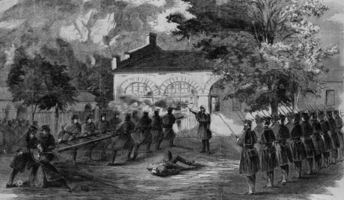Last updated: January 4, 2024
Lesson Plan
Conflicting Values: John Brown and Adin Ballou

- Grade Level:
- High School: Ninth Grade through Twelfth Grade
- Subject:
- Literacy and Language Arts,Social Studies
- Lesson Duration:
- 90 Minutes
- State Standards:
- PS.1, PS.3, PS.4, PS.6, PS.7, USI.T4.1, USI.T4.2, USI.T5.2, RCA-H.1, RCA-H.2, SCLA.1, SCLA.3,
- Thinking Skills:
- Understanding: Understand the main idea of material heard, viewed, or read. Interpret or summarize the ideas in own words. Analyzing: Break down a concept or idea into parts and show the relationships among the parts. Evaluating: Make informed judgements about the value of ideas or materials. Use standards and criteria to support opinions and views.
Essential Question
How do people handle conflict and civil disagreements?
Objective
Students will read primary source accounts about Adin Ballou and the raid at Harper’s Ferry
Students will consider opposing beliefs about violence and civil disobedience.
Background
In October 1859, an abolitionist John Brown led a small militia to raid Harper’s Ferry, West Virginia. These men captured two slaveowners and emancipated the people they held in bondage. While holding the slaveowners hostage, some in Brown’s militia continued on to alert slaves at properties nearby to revolt and join them.
Ten of John Brown’s men were killed and another six arrested and subsequently hanged. John Brown was also arrested and hanged. Six others were killed during the raid. This event increased the national tension significantly. The Civil War broke out just 18 months later.
For decades leading up to the raid, abolitionists disagreed on the best course of action to end slavery. In Hopedale, MA, a community of radicals had participated in the anti-slavery movement by writing newspaper articles, fundraising for fugitives, and hosting anti-slavery events. One particularly outspoken member of this community was Adin Ballou, the one-time leader of this commune who believed strongly in non-violence.
After John Brown’s raid on West Virginia, Ballou found himself at odds with almost all of his fellow abolitionists because of his opposition to the use of violence in the cause for abolition.
This lesson plan was prepared by Hopedale educator Susan Scanlon and edited by park staff.
Preparation
Materials
Background Document
Primary Source Document
Materials
Download Primary Sources for lesson
Lesson Hook/Preview
This lesson plan invites students to consider the conflicting views of leading abolitionists in the years leading to the Civil War. There is a special focus on Adin Ballou, a Practical Christian who advocated for non-resistance, and leaders who supported violent tactics.
Procedure
Review the background document on Hopedale.
Read the primary source document featuring Adin Ballou and William Lloyd Garrisons’s opinions on the raid.
Consider these discussion questions either in pairs or as a group.
While they still shared many abolitionist views in common, this controversial raid drove a wedge between Ballou and Garrison, and between many other abolitionists. Summarize the opinions of both men on John Brown, and then compare and contrast their views.
The Civil War was fought over slavery. Can you imagine a different way that slavery could have been ended in the United States, without violence or war?
Enrichment Activities
Visiting the Site: You can visit Adin Ballou Park in Hopedale, MA, today. It is located at 2 Peace Street, Hopedale, MA.
Additional Resources
Additional Resources: For more information on Hopedale’s History, visit Dan Malloy’s website, hope1842.com.
